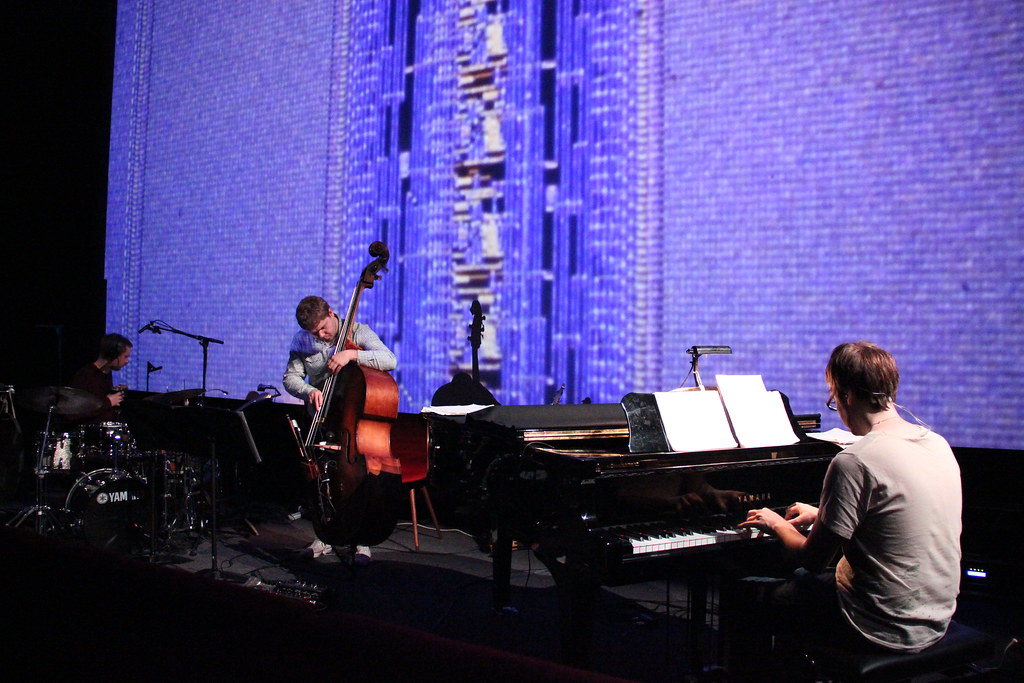I thought it best to let this performance sink in for a day before writing about it, for it is unlike any other.
Koyaanisqatsi (‘Life out of balance’ in the Native American Hopi language) became a cult film in 1982, originally scored by Philip Glass, although I was surprised how many in the audience that I spoke to had never seen it before, perhaps because it was out of print for a decade or so . If you haven’t seen it, it is a 90-minute dialogue-less whirlwind tour of the United States (only) of that era – cities, landscapes and people – mainly using slow motion and time-lapse techniques. To place it, Ronald Reagan had been President for a year when it was released. Two sequels were subsequently made, Powaqatsi and Naqoyqatsi. Their Producer and Director, Godfrey Reggio, is still active, and must surely be thinking in terms of a Donaldqatsi.
For Mancunian “hard-hitting jazz/electronic left field piano trio” GoGo Penguin it is one of their favourite films and in 2015 they wrote their own score to it, commissioned by the then newly-opened Home, a centre for international contemporary art, theatre and film. Tonight’s performance was one of a handful of that score this year including Los Angeles, London and Paris, and the last one, back on ‘home’ turf.
When I recently reviewed their new EP, ‘Ocean in a Drop: Music for Film’, which was inspired by the soundtrack, I quoted pianist Chris Illingworth, who said, “Performing the soundtrack live is hugely demanding, both physically and mentally.” Well I suppose performing ‘Agadoo’ for 90 minutes would be, but this is in a different league altogether. And GoGo penguin’s soundtrack, while being every bit as minimal, is twice as long as the recorded one released by Philip Glass.
One matter that is easily resolved is whether to watch the film or the band. There’s only one winner. While there is more going on in the film than most people can handle, there is virtually nothing happening on stage, where Illingworth is parked to the left, drummer Rob Turner on the right and bassist Nick Blacka in the middle. In fact the only two events of note on a darkened stage where the only light was from the monitors they used to watch the film for cues while they played, like cinematographic click tracks, were when Blacka changed his double bass for an electric bass, and then back again. They just sit or stand there and play. But what a show.
The film and the music start quietly during the opening sequences of canyons, waves and clouds. Too quietly. To be honest, if the show had carried on in the same manner for much longer I’d have been heading towards the bar.
Then it shifts into environmental protection mode for 10 minutes or so (it isn’t just an invention of Greta) and the pace quickens, along with the music. For the most part the band represented the imagery very well, be it of Boeing 747s taking off, military exercises, rush hour queues on LA freeways (there are lots of those), the destruction of tower blocks and power stations, a kaleidoscopic section not unlike Bowman’s descent to TMA-2 in ‘2001 – A Space Odyssey’ or simply the weird and wonderful people of New York going about their daily life, although I thought they missed a trick by not accompanying the prolonged image of an atomic bomb detonation in the desert with a similarly dramatic musical explosion.
It would be impossible to keep changing the score to reflect the ever-changing on-screen images and the music is complex enough as it is, and usually rapid-fire, with some asymmetrical rhythms thrown in from time to time. Instead what happens, or so it seemed to me, is that they opt for a slow but steady progression towards the climax, which is the take-off and subsequent explosion of a space rocket with a lingering focus on the fall to earth of one of its burning parts. I thought I was watching the Challenger shuttle disaster until I realised that was four years later; this was an Atlas Centaur rocket from 1968.
Even so those final 10 minutes or so, which are followed by an epilogue in which the film reverts to its opening images of desert art, are an emotional tour-de-force which is complemented beautifully by this score.
The other peculiarity is that there is no showboating at all. After a brief, almost embarrassed bow to the audience the three musicians shuffled off-stage. Once students at this establishment you’d think they’d just played their final year project to their tutors and peers.
And yet I wish in some ways they would do that at times. While Rob Turner has a crash cymbal I can’t remember him hitting it with any venom, even though there were many occasions when that would have been wholly justified.
But these are minor complaints. As a spectacle – and that is what this is – it really is up there with the most entertaining you’ll ever see, assuming they perform it again. Indeed it makes me wonder why, when Philip Glass was in town, this piece didn’t form part of the Manchester International Festival a few months ago.
A section of Koyaanisqatsi performed in Utrecht in 2017:
Image: https://homemcr.org/event/koyaanisqatsi-live-score-from-gogo-penguin/




